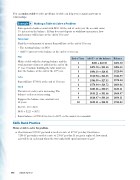Page 895 - Algebra 1
P. 895
You can make a table to solve problems. A table can help you recognize patterns or relationships.
Making a Table to Solve a Problem
Sam opened a bank account with $450. At the end of each year, the account earns 5% interest on the balance. If Sam does not deposit or withdraw any money, how much money will he have at the end of 10 years?
Understand
Find the total amount of money Sam will have at the end of 10 years. • The starting balance is $450.
• Add 5% interest to the balance at the end of every year.
Plan
Make a table with the starting balance and the total amount of interest added at the end of the 1st year. Continue building the table until you have the balance at the end of the 10th year.
Solve
Sam will have $733.02 at the end of 10 years.
Check
The interest each year is increasing. The balance each year is increasing.
Suppose the balance was constant over 10 years.
$22.50 · 10 = $225.
$450 + $225 = $675.
Sam’s balance of $733.02 is close to $675, so the answer is reasonable.
Skills Bank Practice
Make a table to solve the problem.
a. Gas from an 8550 ft3 gas tank is used at a rate of 475 ft3 per day. Gas from a
7200 ft3 gas tank is used at a rate of 250 ft3 per day. If no gas is replaced, how much gas will be in each tank when the two tanks hold equal amounts of gas?
Example
4
End of Year
Add 5% of the balance
Balance
1
$450 + $22.50
$472.50
2
$472.50 + $23.63
$496.13
3
$496.13 + $24.81
$520.94
4
$520.94 + $26.05
$546.99
5
$546.99 + $27.35
$574.34
6
$574.34 + $28.72
$603.06
7
$603.06 + $30.15
$633.21
8
$633.21 + $31.66
$664.87
9
$664.87 + $33.24
$698.11
10
$698.11 + $34.91
$733.02
880
Saxon Algebra 1


